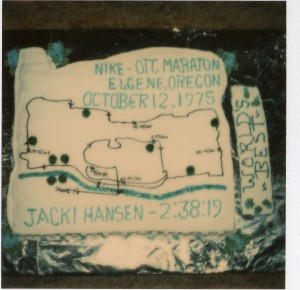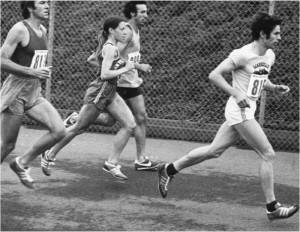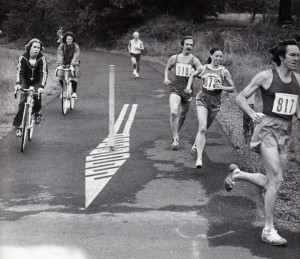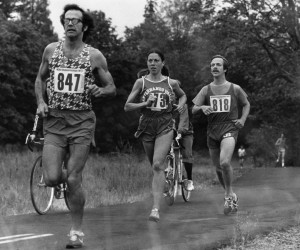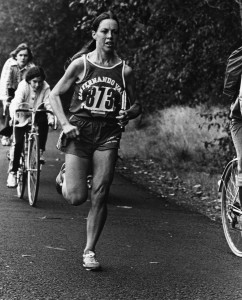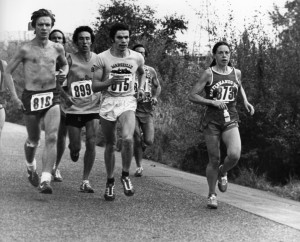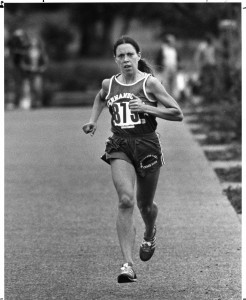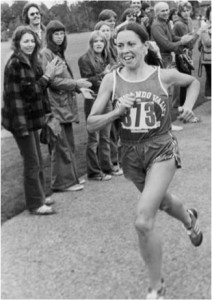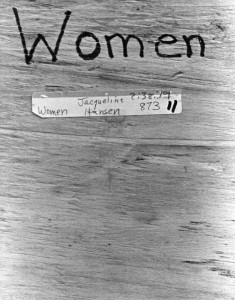On the heels of my last entry and on a brighter note, I recall two distinct races that I would label “peak performances.” As I said before, “sports psychology” was not a term known to me at the time. In one instance I won the race, and in the other, I was out-sprinted to the finish line. But in both cases, it was effortless and euphoric. The winning effort resulted in my 2:38.19 world-record marathon in 1975. To look back and apply sports psych terminology, I would say that I took all the steps necessary to produce a classic “peak performance.” First of all, I “announced” my goal before the race. I understand that “declaration” is part of the process, making it real by telling others. I was on a tune-up run a few days before race day, getting a tour of Eugene, Oregon on my first occasion there. The town was mourning the death of Prefontaine, from his accident just five months earlier. The running tour included where Pre ran, where he raced, where he crashed. Eventually, the running conversation went: “So what sort of time are you aiming for?” Somehow it just rolled off my tongue, “six-minute miles,” I caught myself saying. That must have sounded presumptuous! That comment was met with dead silence, followed by hushed murmurs adding up the figures. On race day, it all came together. I chose Eugene, knowing that the course would be relatively flat, cool, maybe drizzly, and most importantly, accurately measured. The NIKE-OTC (Oregon Track Club) Marathon was run over what was to be the men’s Olympic Marathon Trials course the next year. A sort of dress rehearsal as it were. The race was all of those predictions. Plus, I came into the race feeling good about my workouts. Even my coach, Laszlo Tabori, said at the close of that last interval workout the week before I departed, “you’re ready.” That comment came after my two 5-minute mile repeats I did in the middle of workout, and even though I questioned the connection, I trusted him to know these things. (Joe Henderson printed that workout in his book “Road Racers and Their Training.”)
Tuesday: 2 1/2 mile warm-up; 15 x 100 shakeups – 8 medium, 7 hard; 10 x 400 with 3 hard (73, 71, 72 seconds); 2 1/2 laps easy; 8 x 150 – 2 medium, 1 hard; 5 laps hard (5:13 mile); 2 laps easy; 5 laps hard (5:17 mile); 2 1/2 laps easy; 10 x 200 – 2 hard, 2 medium; 2 laps easy; 12 x 100 shakedowns – 2 medium, 1 hard.
Monday and Wednesday, I did my favorite workout: “25-lappers” both mornings, and an 8-mile run one evening and a 9-mile run the other. Thursday was a modified interval workout, easier than Tuesday’s because I had a race on Saturday. Friday was a brief pre-race run. Saturday I ran a 16:55 cross country 5K race. Sunday I did my last long run of 19 miles before departing for Eugene the next week. Those 25-lap workouts were the best! You could do them anywhere, anytime, without using a stopwatch. I ran a continuous 25 laps consisting of a 5-lap warm-up, then repeated sets of four laps per set: 2 x 100 medium, 2 x 150 build-up, 2 x 100 medium and 2 x 100 hard with an easy jog on the curves in between each.
My friends in Eugene, Janet and Tom Heinonen, arranged for my housing with the Ledbetter family. Young Lili Ledbetter was a local high school track star. We became good friends and her mom made the best ever zucchini bread complete with homegrown filbert nuts. I jokingly say that my race was fueled on zucchini bread, I enjoyed it so much. Throughout the race, Janet and Lili could be found bicycling from station to station, either making sure my bottles of Gookinaid were waiting for me, or more so to check on my progress and splits. I once said in a Sports Illustrated article that “there were days I could run forever. . . ” and gratefully, this was one of those days. To say it felt effortless sounds overly confident, but it was true. In review, my splits averaged 6:02 per mile, my slowest was 6:08 or: 10, and my last 5 miles were at 5:55. I’ve said it before, I cannot do the math when I’m running tired, but that day when I heard my 20-mile split, I could do the math that told me I was ahead of pace, so I immediately picked up the pace and took off, leaving the group of male runners in my company. Looking back, a move like that with six miles to go could have ended badly, but that day it worked. (Story continues below the photos. . . )
Photographs by Doug Schwab
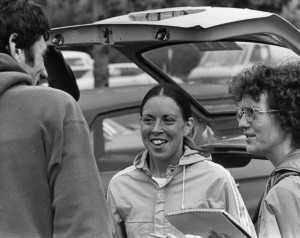
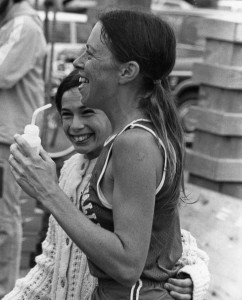
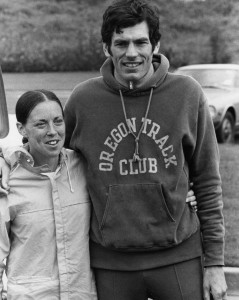
Look at the picture above, the one with only me in the frame – the one with my glassy-eyed look on my face and not smiling. A sports psychologist once showed me a group of racing photos and pointed out that he could predict the athlete who was going to run well — the one with the glassy-eyed look, the one who is focused and able to shut out all distractions. I approached the finish line in 11th place and someone yelled from the sidelines, “Catch one more guy! Top ten get watches!” But I had something more valuable on the line. What I felt upon finishing, besides pure elation, was a sense of no time passing. To say it reminded me of getting my wisdom teeth pulled doesn’t quite elicit the reaction I intend unless I explain that it was the part about coming out of a deep anesthesia slumber, is going to begin only to discover the procedure is over. It was that type of sense of no time passing. Almost an out of body experience, because simultaneously I had the clear recollection of every mile run, every water station, every split, every inch of the course. I’ve got great pictures from my friend, Doug Schwab, and a great story written by my friend, Tim Wason. Thanks to Janet Heinonen, it was written up in the OTC newsletter, so the experience was well documented. The icing on the cake, if you’ll pardon the pun, was the cake in the shape of the state of Oregon, that my friend Leal-Ann Reinhart had made for my celebration party when I returned home.
Now if I could bottle up and patent that formula which made for the “peak performance,” and pull it out of my repertoire for every race, my career would’ve been even more illustrious; or I might have become a world-class coach. However, it was simply one of those marvelous times that I will treasure, feeling fortunate to ever have such an experience. It has, however, piqued my interest all these years and I intend to investigate it further for another article, another day.
